
Chandra Shekhar Sitaram Tiwari (23 July 1906 – 27 February 1931), popularly known as Chandra Shekhar Azad, was an Indian revolutionary. Chandra Shekhar Azad was born in Bhabhra village as Chandra Shekhar Tiwari, in a Brahmin family, in the princely-state of Alirajpur. His forefathers were from Badarka village of Unnao district of Uttar Pradesh. His mother, Jagrani Devi, was the third wife of Sitaram Tiwari, whose previous wives had died young. After the birth of their first son, Sukhdev, in Badarka, the family moved to Alirajpur State.
His mother wanted her son to be a great Sanskrit scholar and persuaded his father to send him to Kashi Vidyapeeth at Banaras to study. In 1921, when the Non-Cooperation Movement was at its height, Chandra Shekhar, then a 15-year-old student, joined. As a result, he was arrested on 20 December. On being presented before the Parsi district magistrate Justice M. P. Khareghat a week later, he gave his name as “Azad” (The Free), his father’s name as “Swatantrata” (Independence) and his residence as “Jail”. The angered magistrate punished him with 15 lashes.
After the suspension of the non-cooperation movement in 1922 by Mahatma Gandhi, Azad became disappointed. He met a young revolutionary, Manmath Nath Gupta, who introduced him to Ram Prasad Bismil who had formed the Hindustan Republican Association (HRA), a revolutionary organization. He then became an active member of the HRA and started to collect funds for HRA. Most of the fund collection was through robberies of government property. He was involved in the Kakori Train Robbery of 1925, the shooting of John P. Saunders at Lahore in 1928 to avenge the killing of Lala Lajpat Rai, and at last, in the attempt to blow up the Viceroy of India’s train in 1929.

Azad got to read Karl Marx’s Manifesto of the Communist Party from his comrade Shiv Verma. When Azad was the commander-in-chief of the revolutionary party, he often use to borrow a book called ABC of Communism from writer Satyabhakta to teach socialism to his cadres. Despite being a member of Congress, Motilal Nehru regularly gave money in support of Azad. see Full activism and bio at wiki
Death –
On 27 February 1931, the CID head of the police at Allahabad, J. R. H. Nott-Bower was tipped off by someone that Azad was at Alfred Park and was having a talk with his companion and aide Sukhdev Raj. On receiving it, Bower called on the Allahabad Police to accompany him to the park to arrest him. The police arrived at the park and surrounded it from all four sides. Some constables along with DSP Thakur Vishweshwar Singh entered the park armed with rifles and the shootout began. Azad killed three policemen but was badly wounded in the process of defending himself and helping his colleague Raj. Azad told him to move out in order to continue the freedom struggle and gave him cover fire for Raj to safely escape from the park. Azad hid behind a tree to save himself and began to fire from behind it. The police fired back. After a long shootout, holding true to his pledge to always remain Azad (Free) and never be captured alive, he shot himself in the head with his gun’s last bullet.
Birth Chart of Chandra Shekhar Azad– Born 23 July 1906 at 2:40 pm, Bhavra.











